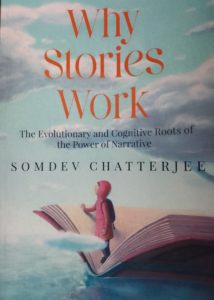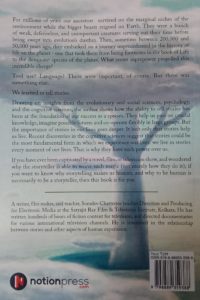By Sayak Pal

A story can make you feel happy, angry, joyful, frustrated, sorrowful, or experience any emotion you can ever imagine. Have you ever wondered, though, why we are so captivated by the stories that we read or hear? What is the source of the mysterious power that the storyteller wields over us? Somdev Chatterjee in his book Why Stories Work: The Evolutionary and Cognitive Roots of the Power of Narrative sheds light on this intriguing question that has been discussed in the humanities for millennia. Instead of relying on traditional literary theories, the author gleans insights from recent scientific advances in our understanding of our evolutionary past and the structure of our brains and minds.
We love stories because they entertain us. However, it turns out that is not their only or even their primary function. Stories have been instrumental in helping the human race survive because they are one of the earliest ways in which knowledge and values were shared in a group. How to survive an encounter with a lion? How to become a great leader? What is my place in my tribe or community and who are our friends and enemies? Early humans found answers to these questions in the stories they heard and passed on to others. In fact, we still do. Stories helped humans pool their knowledge and experience, and foster feelings of kinship in a group allowing them to cooperate flexibly in large numbers. In the brutal competition with much stronger predators, this was the secret superpower that kept us alive. Because storytelling was so advantageous for survival, evolution gradually killed off all the non-storytelling people so that there is no tribe, community, or nation living today that does not tell stories. We are all children of the storytellers who survived.

The importance of storytelling is not limited to its contribution to our survival as a species. In the third chapter of his book, the author draws on a host of recent scientific experiments that prove how limited our sensory and cognitive resources are. We think we perceive all or most of the environment around us, but that is an illusion. We actually perceive only a tiny bit of the reality around us. Which part of our environment we pay attention to, and which aspect of it we grasp most readily is determined by the imperative of survival. “Therefore, we do not see what is, but what matters – our perception comes loaded with an inherent value judgement determined by the imperatives of survival and reproduction and the deepest, most real categories we can perceive are not the categories of being, but those related to action.” The author asserts that our perception of reality itself occurs in a mould that resembles the structure of stories. In this framework, we view our current state as a starting point and aspire to reach a more desirable future state. We selectively focus on elements that can aid or hinder our journey, such as goals, tools, obstacles, rivals, friends, and so on. These aspects of people or things evoke the strongest responses from us. This leads to the most important insight of the book: “It is possible that stories are maps of the deepest layer of reality we can know – not the scientific reality of value-neutral things, but the psychological reality of a world of value-laden objects in the field of goal-directed action.” This explains the almost magical power that they have over us.
Why Stories Work offers many such insights. Adopting psychological, physiological, and sociological perspectives, the author talks about stimulus, beliefs, faith, habits, trials, behaviours, learning passed down to us from our ancestors, socio-cultural learnings, and many other facets that throw new light on stories. This book draws heavily on science, but it is not for science buffs. Instead, it is for those who want to understand the power, importance, and structure of stories and their relationship with other aspects of the human experience. Another important feature that makes us fall in love with stories is the amount of learning we undertake in the process. Somdev Chatterjee explains the study of narratives through evolutionary sciences, cognitive sciences, developmental psychology, and philosophy that support the claim of stories being loved by readers. If you love stories and want to understand them more deeply, you might want to give this book a try.



